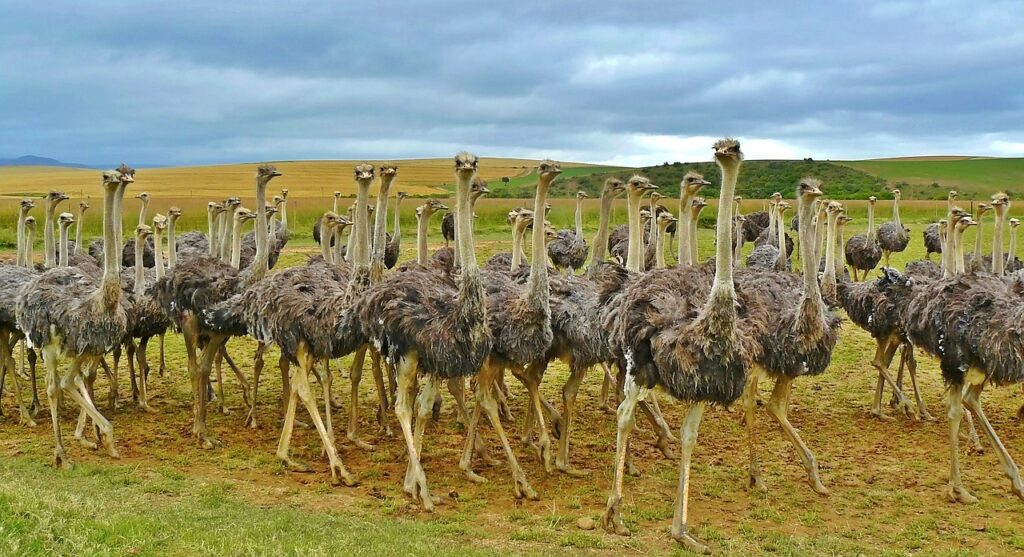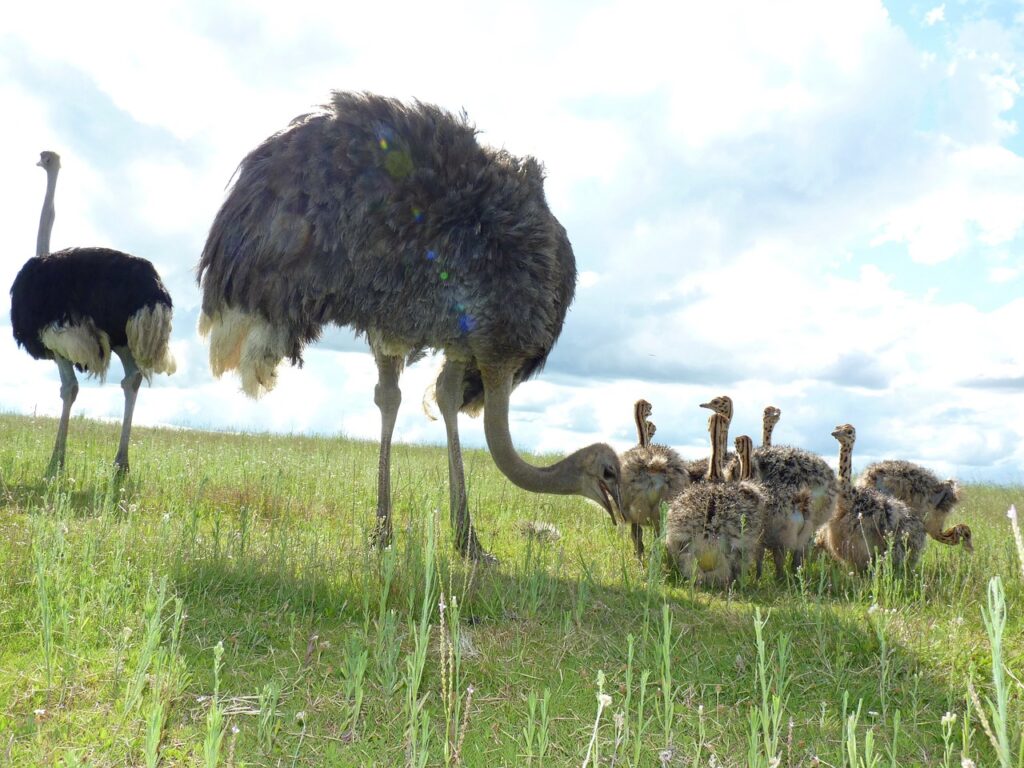The Ostrich Bird: Physical Features and Life Cycle
The ostrich is the world’s largest and heaviest bird. It is famous for its size, speed, and unique characteristics. Although it cannot fly, the ostrich is a powerful runner and has many interesting traits that make it stand out in the bird kingdom. In this article, we will explore everything about the ostrich – from its appearance and behavior to its habitat, diet, reproduction, and relationship with humans.

1. Introduction to the Ostrich
The ostrich belongs to a group of flightless birds called ratites. Other birds in this group include emus, rheas, and kiwis. The scientific name of the common ostrich is Struthio camelus. It is native to Africa, where it roams in open grasslands and savannas.
2. Physical Features
Size and Weight
Ostriches are huge birds. They can grow up to 9 feet (2.7 meters) tall and weigh between 220 and 290 pounds (100 to 130 kg). Males are usually taller and heavier than females.
Wings and Feathers
Even though ostriches cannot fly, they have large wings that span over 6 feet (2 meters). These wings help with balance and are used in mating displays and for shading chicks. Their feathers are soft and fluffy, unlike the stiff flight feathers of flying birds.
Long Legs and Toes
Ostriches have long, strong legs that make them excellent runners. Each foot has only two toes, unlike most birds which have three or four. One of the toes is much larger and acts like a hoof, helping them run fast.
Eyes and Beak
Ostriches have the largest eyes of any land animal, measuring about 2 inches (5 cm) across. Their excellent eyesight helps them spot predators from far away. They have a flat, broad beak, which is good for picking up food.
3. Where Ostriches Live
Habitat
Ostriches live in dry, open areas like savannas, grasslands, and semi-deserts. These regions are mostly found in eastern and southern Africa. Ostriches avoid forests and wetlands because they need wide spaces to run and see danger coming.
Adaptations to the Environment
Ostriches are well adapted to hot, dry climates. They can survive without water for several days by getting moisture from the plants they eat. Their body temperature can change slightly to save water, and they pant like dogs to stay cool.

4. Ostrich Behavior
Social Life
Ostriches are social animals. They often live in small groups of 5 to 50 birds. During the breeding season, males may gather a harem of females. These birds communicate with each other using hissing, booming sounds, and body movements.
Running and Defense
Ostriches are the fastest birds on land. They can run at speeds of up to 45 miles per hour (72 km/h) and cover about 10 to 15 feet in a single stride. When threatened, they either run away or use their powerful legs to kick. An ostrich kick can injure or even kill a predator like a lion.
5. Diet and Eating Habits
Herbivores
Ostriches are omnivores, but they mostly eat plants, especially seeds, roots, grasses, and leaves. They also eat insects, lizards, and small animals when available. They often swallow small stones or pebbles to help grind up food in their gizzard, as they have no teeth.
Water Needs
Ostriches can go for days without drinking water, especially in the wild. They get most of their water from the food they eat. However, when water is available, they will drink and even bathe in it.
https://sypertimes.com/burj-khalifa-worlds-tallest-marvel-and-iconic-sphere/
6. Reproduction and Life Cycle
Mating Behavior
Male ostriches perform a fancy dance to attract females, flapping their wings and moving their necks in a special way. Once a female accepts the male, they mate.
Nesting
The male digs a shallow hole in the ground to serve as a nest. The dominant female lays her eggs first, followed by others in the group. Ostrich eggs are the largest eggs in the world, weighing about 3 pounds (1.4 kg) each.
Egg Incubation
Both the male and the dominant female take turns sitting on the eggs. The female usually incubates during the day, and the male at night. This helps keep the eggs safe from predators. The incubation period lasts about 42 days.
Chicks
Once hatched, ostrich chicks can walk and feed themselves almost immediately. They grow very fast and can reach adult size within 6 months. However, only a few chicks survive to adulthood due to predators like jackals, eagles, and hyenas.

7. Predators and Threats
Natural Predators
Adult ostriches are large and strong, so few animals dare attack them. However, eggs and chicks are vulnerable to predators such as:
- Jackals
- Hyenas
- Eagles
- Lions
- Cheetahs
Defense Mechanisms
Besides running and kicking, ostriches use their sharp eyesight to detect predators early. In groups, one bird usually watches while others feed.
8. Ostriches and Humans
Domestication
Ostriches have been domesticated in some parts of the world. Ostrich farms raise them for:
- Meat: Low in fat and cholesterol
- Leather: Soft and durable, used in fashion
- Feathers: Used for decorations and costumes
- Eggshells: Used in art and crafts
Tourism and Conservation
In some African countries, ostriches are a big part of wildlife tourism. Visitors enjoy watching them in national parks or on safari. Ostrich rides and races are also tourist attractions in some areas.
9. Fun Facts About Ostriches
- Ostriches do not bury their heads in the sand. That is a myth! They lower their heads to the ground to look for food or to hide from predators.
- Their eggs are so strong that a person can stand on them without breaking them.
- Ostriches can live up to 40–45 years in captivity and around 30–40 years in the wild.
- A group of ostriches is called a herd or a flock.
- Ostriches have three stomachs to help digest their food better.
10. Conservation Status
The common ostrich is currently listed as “Least Concern” by the International Union for Conservation of Nature (IUCN). However, one subspecies known as the Arabian ostrich went extinct in the 20th century. Some wild populations have decreased due to hunting, habitat loss, and climate change. Conservation programs and ostrich farming have helped stabilize their numbers.

11. Ostriches in Culture and History
Throughout history, ostriches have appeared in:
- Ancient Egyptian art, symbolizing truth and justice
- Roman times, where they were hunted in arenas
- African folklore, where they are often seen as wise or tricky animals
- Modern logos and emblems, especially in Africa
Ostrich feathers were once a major part of fashion in Europe and America during the 19th and early 20th centuries.
12. Conclusion
The ostrich is truly a unique and fascinating bird. From its enormous size and powerful legs to its amazing speed and survival skills, the ostrich has adapted well to life in the wild. It plays an important role in the ecosystem and also holds economic and cultural value for humans. By learning more about ostriches and supporting conservation efforts, we can help protect this incredible species for future generations.
https://www.jagranjosh.com/general-knowledge/largest-bird-in-the-world-1746440409-1




